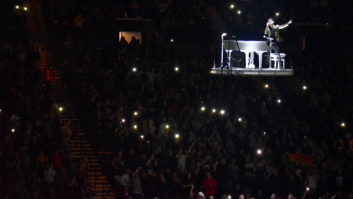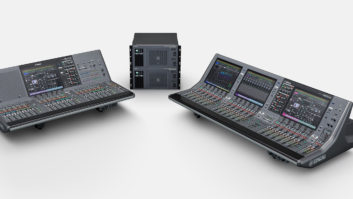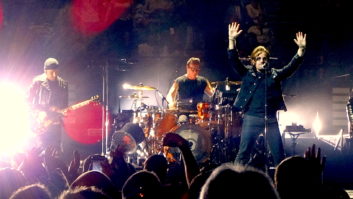Ghost’s blatantly—though arguably tongue-in-cheek—occult image and lyrical content is specially crafted to shock and titillate in a cerebral way, while its earwormy, doomy discography sounds both familiar and fresh at the same time, making it AOR radio-tested, Satan approved. Confirming that broad appeal, the Swedish band is up for Grammy Awards for Best Rock Song and Best Rock Album this month, but for a real revelation, all one has to do is look at who attended the recently completed North American leg of the band’s A Pale Tour Named Death. The audiences were a true amalgamation of music fans young and old, of tastes ranging from black metal to ABBA, with appearances ranging from dedicated goth to common soccer mom.
“There are kids, people bringing their kids, and there’s people in their late 60s and early 70s wearing golf shirts,” says the band’s FOH engineer, Dave Nutbrown. “They know the songs. A good song is a good song. People will always love a good song—and that’s what Ghost has: lots of good songs. Instead of one or two songs people really want to hear, there’s 15 out of 20 songs that people really want to hear. With Ghost, the show runs two hours and 15 minutes and people are really entertained until the last song. That’s why Tobias [Forge, band mastermind and vocalist behind Ghost’s ever-evolving “Papa” characters] is up for two Grammys—because there are so many good songs.”
From large theaters to major city arenas, A Pale Tour Named Death hit a wide range of venues with a remarkably clean staging scheme for its as many as nine performers: Forge’s “Cardinal Copia” character, seven “Nameless Ghoul” instrumentalists and, for a song, one very old-looking saxophonist (“Papa Nihil”). No amplifiers, no speaker cabs and no wedges were visible, allowing the predominately white cathedral-like staging to feature theatrical performances that owed more to Broadway than Ozzfest.

“We have no backline, really,” Nutbrown notes of the tour’s relative simplicity. “And in the individual domain, we have no wedges on stage, no sides, no drum fills. All IEMs are Sennheiser ew300 transmitters and packs, and each musician has his own ear molds. For us, it’s the choice of what to hang for the main racks and stacks; it’s about being well-equipped for the building. That’s our main criteria. The venue size isn’t really an issue because I’m not fighting against anything. Everything comes to me clean, and it’s a blank canvas straightaway.
“Drums are really the only instruments that are miked,” explains Nutbrown. “It’s organic, with no samples or triggers. We’re using Shure 91A and 52A on kick drum, SM98 and SM57 on snare, Audio-Technicas on hi-hats and toms, and the Aston Origin [LDC cardioid condenser] as a pair overhead as well as on the side. The Origin came recommended and is really, really good—not expensive. The only thing we’re using that really pushes the boundaries of technology is the KLANG:technologies 3D in-ear mixing system for main vocal monitoring. It’s brilliant. Everything else is rather standard, off-the-shelf audio gear.”
Related: Live Sound Showcase: Going International with Phil Collins, by Clive Young, Oct. 26, 2018
Throughout the tour, the band picked up local P.A.s or used house systems as needed. “For P.A., in all fairness, a lot of the decisions are already made for us by the venue,” Nutbrown continues. “In the bigger venues, people are getting choice of P.A.—I can discuss it with the vendor, and whether we will fly or stack, but in a lot of the theaters we go into, unfortunately, we have to handle the hand we’re dealt. We do tend to look for a bit more low end than you may normally find, especially in theaters that tend to have more of an emphasis on mid-high clarity. We’re not a massive low-end band, but we do have some samples that rumble the foundations. When we find a d&b audiotechnik or Meyer Sound system, it’s great; we just like to make it a nice, sonically-balanced evening.”
Nutbrown’s mixing approach with Ghost is best described as well balanced and full, aesthetically organic and classic, but, as he readily points out, he’s “not mixing Marshall stacks at 10 and 11. Everything comes to me clean, and the groundwork for the sounds is all drawn: the guitar processors, the bass processors, the keyboard sounds. I don’t use any plug-ins, no outboard. Everything I use is in the Soundcraft Vi3000 console that I’ve used for years. It’s easy to put things into place; I can bring in my EQ and dip the frequencies. Monitors and I are sharing a common 64-channel Vi stagebox; I’m using 48 channels.”

“I started using the Soundcraft Vi6 15 years ago,” explains Nutbrown of his affinity for the British, Harman-owned brand. “For me, visually, everything is one press away. I can’t really get my head around the consoles where you have to press into two to three menus to get to something you really want to do. The Soundcraft Vi3000 lays out really easily, too; I can have everything on two and a half layers with a comfortable footprint. There are some great consoles out there, but I don’t want to chase technical [issues] around. For me, it’s familiarity.”
While he began using Vi desks 15 years ago, Nutbrown’s career goes further back. After formative years tackling local live sound in his native England, Nutbrown graduated to a front-of-house gig with Squeeze, followed by more than a decade of working primarily with metal bands including Mastodon and Bullet for My Valentine. His tenure with Ghost began two years ago, around the time that the act won the 2016 Grammy Award for Best Metal Performance (“Cirice” from Meliora).
Related: Allen & Heath Takes Bullet on Tour, Oct. 16, 2015
The job keeps him busy, too. An evening with Ghost features nonstop audio, with pre-recorded intro, intermission and post-show aural atmospheres that are seamlessly stitched to live performances. “It’s a Vatican-like choir singing first, then with the articulate live performances, then the intermission, back to the music, then out,” sums Nutbrown. “Basically, from the start to the end, there’s no musical stop, with playback in between songs.”
Transitioning between Ghost’s distinct tonalities from album to album in a live setting is smooth largely thanks to pre-tour groundwork by the players behind the masks on stage, Nutbrown explains. “Because all the stems are available, they can get them from the album and pull them in, [allowing the individual musicians to] sound like the albums, especially the clean sounds. The guys [Nameless Ghouls] we have now are very, very hands-on, creating unique nuances around the original sounds, giving the performances a little embellishment—adding some reverb, chorus, making it a bit more swimmy or drier. It’s about making it sound like the album, but different from the album.

“They are all great, hands-on players and understand their equipment,” Nutbrown continues, adding that it’s rare the band changes anything sonically, except for the recent addition of a Tech 21 GED-2112 Geddy Lee Signature rackmount bass preamplifier/DI in order to “put a bit more attack into the bass guitar.”
Want more stories like this? Subscribe to our newsletter and get it delivered right to your inbox.
As Ghost continues touring largely 15,000- to 20,000-seat venues in 2019, with Europe and Australia looming on the schedule, the band will be carrying a Meyer Sound LYON self-powered linear line array system. The current busy pace is expected to continue, as Ghost’s leader is said to always have a five-year plan sketched out for the band.
“He [Forge] never stops writing,” observes Nutbrown. “When we finished the last album cycle for Meliora, apparently this album, Prequelle, was already written. I’m not really sure where we will go after this; the album has been received so well. So many people have come out to hear the show and to see the full spectacle—it’s not your everyday show.”
Soundcraft • www.soundcraft.com
Ghost • www.ghost-official.com






